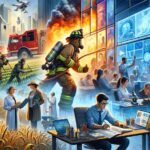
Key Takeaways
- Political Messaging: Politicians shape opinions on guns through targeted messages and campaign strategies.
- Media Influence: Media coverage plays a significant role in shaping how people view gun violence and ownership.
- Regional Differences: Attitudes toward guns vary widely between different areas and can impact policy preferences.
- Demographic Factors: Your background influences how you view gun control and safety.
Understanding these factors can help you make sense of why gun control debates are so diverse and heated.
The Impact of Political Messaging on Public Views About the Increase in Guns
How Politicians Shape Opinions
Campaign Strategies: Politicians use campaign messages to sway public opinion on gun control. For example, a candidate may highlight concerns about rising gun violence to push for stricter regulations, while another might emphasize Second Amendment rights to advocate for fewer restrictions.
Messaging Effects: The way a message is framed can significantly impact how people perceive gun ownership. Fear-based messaging might lead to support for more restrictions, while freedom-focused messaging might bolster support for less regulation.
Example: During election seasons, candidates often use statistics and emotional appeals to make their case. A politician might cite a recent shooting to argue for stronger gun control, whereas another might use the same event to emphasize the need for armed self-defense.
Comparative Analysis of Gun Rights and Gun Control Perspectives Among Different Ethnic Groups
Ethnic Differences in Gun Control Views
Cultural Factors: Different ethnic groups may have varying perspectives on gun ownership based on cultural values and historical experiences. For instance, some communities might have strong traditions related to hunting and gun use, while others might focus more on the need for regulation due to concerns about violence.
Historical Context: Historical experiences with gun violence or discrimination can also influence opinions. For example, groups that have faced systemic violence might advocate for stricter gun laws, while others might stress the importance of self-defense.
Example: African American communities might have different views on gun control compared to Hispanic or White communities, influenced by their unique experiences and cultural backgrounds.
The Role of Media in Shaping Attitudes Toward Gun Violence and Gun Ownership
How Media Coverage Influences Views
Media Framing: The way gun-related stories are reported can shape public perceptions. For example, sensational coverage of mass shootings might increase support for stricter gun control, while focus on self-defense stories might bolster support for gun rights.
Bias and Representation: Media outlets often have biases that affect how gun issues are portrayed. Understanding these biases helps you critically evaluate the information presented.
Example: If a news outlet frequently reports on gun violence in a specific way, such as emphasizing the need for regulation, it can influence public opinion to align with that perspective.
How Party Affiliation Influences Perceptions of Gun Safety and Control Measures
Political Leanings and Gun Policies
Red States vs. Blue States: Republicans generally support gun rights and less regulation, while Democrats often advocate for stricter gun control measures. Your party affiliation can strongly influence your views on gun policies.
Legislative Impact: Party-controlled legislatures can push for policies that reflect their party’s stance on gun control. This can lead to significant differences in gun laws and safety measures across states.
Example: In a red state like Alabama, you might find fewer gun restrictions and stronger support for gun rights, while in a blue state like New York, there are likely to be more stringent gun control laws.
The Effect of Regional Differences on Gun Ownership Trends and Policy Preferences
How Location Affects Gun Views
Urban vs. Rural: People living in urban areas often support stricter gun control due to higher rates of gun violence, while rural residents may advocate for fewer restrictions, valuing guns for hunting and self-defense.
Regional Trends: Different regions have unique trends in gun ownership and policy preferences, influenced by local crime rates, cultural attitudes, and historical factors.
Example: In rural Texas, high gun ownership and fewer regulations reflect local values, while in urban California, strict gun control measures are more common due to concerns about gun violence.
Analyzing the Impact of Gun Ownership on Electoral Outcomes in Key Battleground States
How Gun Issues Affect Elections
Swing States: In battleground states, gun ownership and control can be pivotal issues. Candidates might tailor their messages on gun policies to sway voters in these crucial states.
Electoral Impact: Voters’ views on gun control can influence their support for candidates and ultimately affect election outcomes.
Example: In states like Pennsylvania and Florida, where gun issues can be decisive, candidates often focus on their stance regarding gun control to attract voters.
The Role of Demographic Factors in Shaping Public Opinions on Gun Rights and Safety
How Demographics Influence Views
Age, Gender, and Education: Your demographic background plays a significant role in shaping your views on gun rights and safety. For instance, younger people and women may be more supportive of stricter gun control, while older and more educated individuals might have different priorities.
Regional and Cultural Influences: Local culture and experiences also impact how demographics view gun ownership and control.
Example: Young, urban professionals might lean toward supporting stricter regulations, while older, rural individuals might prioritize preserving gun rights.
Comparative Study of Gun Control and Safety Opinions Among Different Political Ideologies
Ideological Differences
Conservatives vs. Liberals: Conservatives often emphasize individual rights and less regulation, while liberals generally advocate for more control to enhance public safety. These ideological differences shape opinions on gun policies and safety measures.
Policy Preferences: Your political ideology influences which policies you support and how you view issues like gun violence and safety.
Example: A conservative might focus on preserving Second Amendment rights, while a liberal might support policies aimed at reducing gun violence through regulation.
How Gender Differences Affect Policy Preferences on Gun Ownership and Safety
Gender and Gun Policy
Women: Generally more supportive of stricter gun control due to concerns about safety, particularly related to domestic violence and crime.
Men: Often prioritize gun rights and self-defense, reflecting a focus on personal freedom and protection.
Example: Women may advocate for policies like background checks and assault weapon bans, while men might support measures that ensure the right to own and carry firearms.
The Influence of Crime Rates on National Gun Control Policy Discussions
Crime Rates and Policy Changes
Link Between Crime and Policy: High crime rates often lead to increased calls for stricter gun control measures, while lower crime rates might shift focus to maintaining existing laws.
Policy Responses: Governments and policymakers might adjust their stance on gun control based on changes in crime statistics and public safety concerns.
Example: An increase in gun-related crimes might prompt a push for tougher regulations, while a decrease might lead to discussions about preserving current laws.
Conclusion
Political messaging, media coverage, regional differences, and demographic factors all play crucial roles in shaping public views on gun ownership and control. By understanding these influences, you can better grasp the complexities of the gun control debate and how various factors drive differing opinions. For more insights into this topic, check out resources from The New York Times and The Giffords Law Center.






